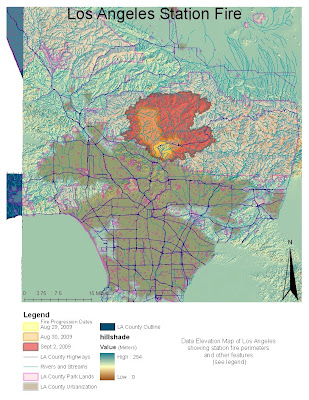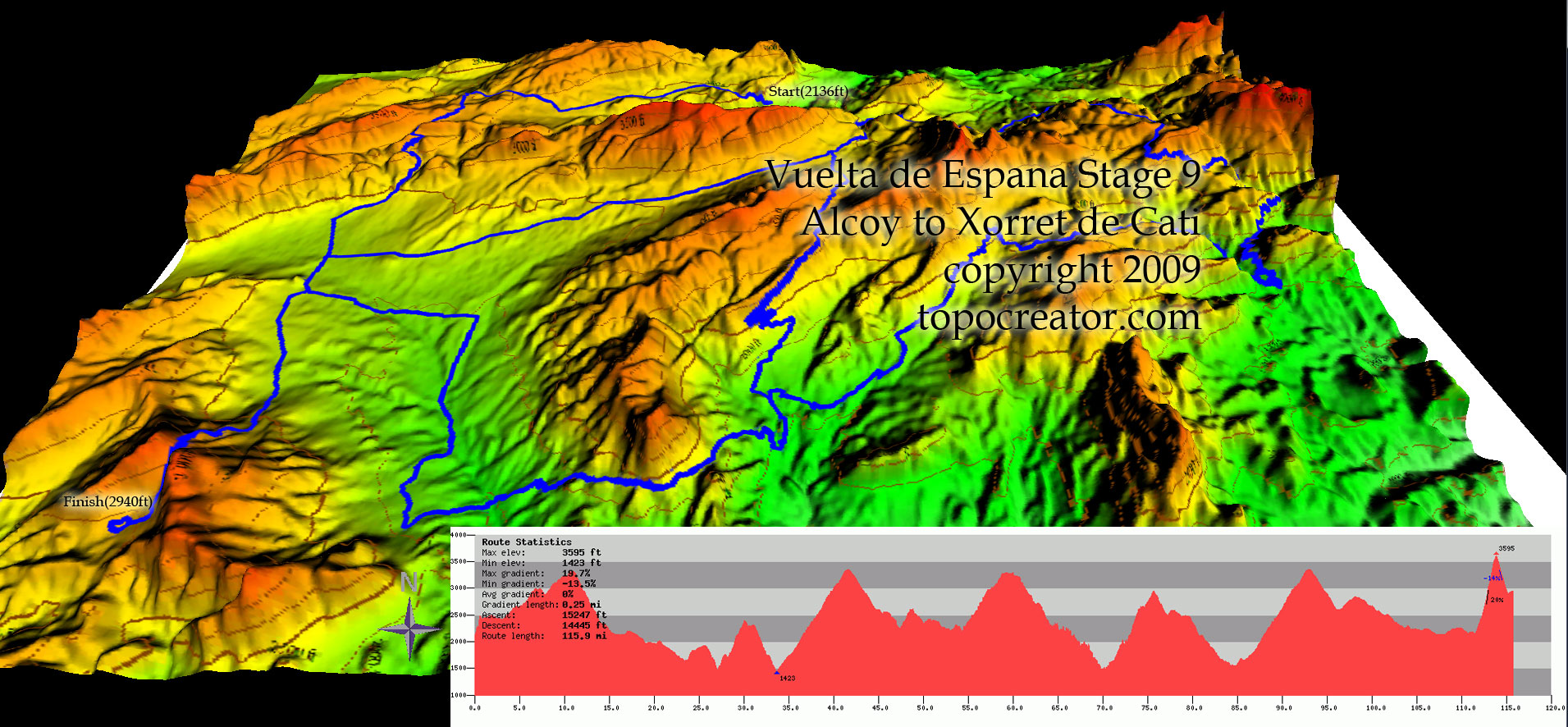
The Los Angeles County Station Fire raged through the Angeles Forest and surrounding areas from August 26, 2009, through October 16, 2009. In this time span, the fire burned about 160,577 acres, claimed the lives of two fire fighters, destroyed 209 structures (89 were homes), and cost the state over $93.8 million to fight and finally extinguish. The featured map shows the spread of the fire during the first week, as well as distinguishes the urbanized part of Los Angeles from the less populated parklands (where the fire occurred). I will refer to the features shown on the map as I present a report about the nature of fires in the Chaparral ecosystem of Southern California, and our water resources.
The Station Fire was the largest in a list of intense, powerful, and far-reaching wild fires in recent Southern California history. Why the sudden rise in the intensity of wild fires? There are lots of factors that explain the cause of fires: our dry weather, Mediterranean climate, recent drought (creating dry vegetation/fire fuel), and of course the emergence of Santa Ana winds during the dry, end of summer heat. All these factors contribute to the rising intensity of fires. However, one factor that allows the accumulation of dry brush, and thus providing fuel for crazed wild fires, is actually the lack of fires. Fires are a natural part of many forest/chaparral ecosystems, like those present in the Angeles forest. Here in Southern California though, we tend to prevent any and all fires that may arise, and extinguish those that do arise as soon as possible. Looking at our map, we can see why this would be in our interest. With the Angeles Forest being in such proximity to residential areas, and not to far from the urbanized section of Los Angeles, it is in an effort to protect our infrastructure, cities, and homes from any fire damage by trying to prevent them all together.
It is hard to believe that flames (from controlled fires) have a potential to benefit ecosystems, and even to prevent larger wildfire events. How could this be? Over time, leafs, excess brush, and other dead vegetation cover the grounds of forest/chaparral ecosystems. In doing so, the piles of dead vegetation that cover the soil both prevents seeds from getting into the soil and germinating, thus preventing the rise of biodiversity in the ecosystem, and produces an increased supply of fuel for a future raging fire. The use of periodic controlled fires to reproduce the effects of natural fires, could get rid of excess/dead vegetation, preventing the compilation of too much fuel and thus lessen the chance of a wildfire going out of control. Doing so, will also allow new generations of plant species to germinate and grow in the soil (which is replenished with nutrients after the fire), increasing biodiversity and strengthening the gene pools of the present species. Fire can be used in a positive way before allowing it to emerge as a destructive force.
Directing our attention to the map once more, we see that there are a myriad of streams and rivers in the LA county parklands represented in pink. The extensive network converges to a few large arteries by the time the moving water comes over the mountains and reaches the urbanized area of Los Angeles further south. Keep in mind that parts of these larger arteries are potentially dammed for storage of water/production of electricity, or provide recreational use for some communities. With that said, what sort of negative effects could such a large fire have on our water supply? First off, an increased amount of sedimentation and debris is likely to make its way into streams/rivers, which itself will lead to other results. If much of the debris is organic, such as dead brush, it could have a negative impact on the aquatic ecosystem. The increased organic matter in the water will be perfect for hungry bacteria to feast, and multiply rapidly. The rapid growth of bacteria will decrease the amount of dissolved oxygen in the water, which means fish and other animals will be unable to garner oxygen to live and their populations will decline leading to many more negativities such as eutrophication that would need a separate report to describe. The message here is that it (increased sedimentation) can decrease the water quality that may be used by communities down stream, and/or eventually empty out into the ocean. Another effect would be the debris itself. It could flow and cause blockages down stream, such as at a dam, and thus block hydroelectric production at said dam, or simply pollute a dammed body of water that is used for recreational purposes by the public. Extreme fire events pose a threat to the health of the water sources of Los Angeles County.
In conclusion, aggressive fire events pose a myriad of environmental and other issues. The burning of vegetation near residential areas in the hills creates the threat of destructive mudslides when the winter rains begin, as well as results in immense amounts of air pollution, and threatens the health of the already limited natural supply of water in Los Angeles County. Perhaps it is our fault for preventing the occasional fire nature desires in order to protect our cities. Regardless, further research should be done to find ways of reducing the frequency of extreme fire events, and maybe we will learn that producing small, seasonal, and most importantly, controlled fires will be the way to go.
References:
Barkley, Yvonne. "Wildfire and Its Effects on Streams and Rivers - EXtension." Wildfire and Its Effects on Streams and Rivers. Extension: University of Idaho Extension, Moscow, ID, 20 May 2010. Web. 24 May 2010.
Bowes, Peter. "BBC News - Learning to Love Forest Fires in Yosemite National Park." BBC NEWS | News Front Page. 3 Dec. 2009. Web. 24 May 2010.
"Chapparal." Chaparral. Cal Poly Land. Web. 24 May 2010.
"InciWeb the Incident Information System: Station Fire News Release." InciWeb the Incident Information System: Current Incidents. Incident Information System, 27 Sept. 2009. Web. 24 May 2010.
Los Angeles County GIS Enterprise. Los Angeles County. Web. 24 May 2010.
Mapshare: UCLA's Spatial Data Repository. UCLA GIS. Web. 24 May 2010.
The National Map Seamless Server. Web. 24 May 2010.
B










